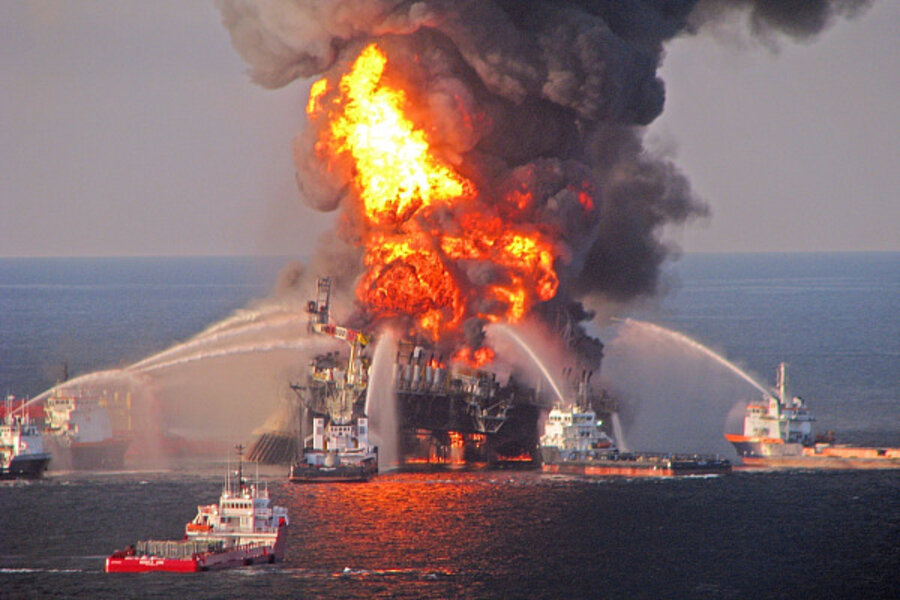Gulf oil spill: the 51 minutes that led to disaster
Loading...
| Washington
Fifty-one minutes before it exploded, the oil well beneath the Deepwater Horizon drilling rig began showing signs of impending doom.
The date was April 20, the time early evening. Rig workers were pumping fluid into the well, getting ready to cap it and move on to another job. But more fluid was coming out than was going in. What was going on?
Forty-one minutes before the explosion they shut down the pump for a “sheen test” – an EPA-mandated step intended to spot free oil floating to the surface. With no pump running, the well flow should have stopped. It didn’t. Fluid kept coming up – and sensors showed that pressure in the drill pipe unexpectedly was increasing.
IN PICTURES: Louisiana oil spill
Eighteen minutes before the explosion the situation began to escalate. Pressures began to reach abnormal levels. Mud was coming to the surface. The pump – which had been restarted – was abruptly shut down.
We don’t really know what happened in the next fateful minutes. There’s evidence the crew tried some sort of “mechanical intervention,” according to a congressional memo. But the flow of fluid and the increase in pressure continued to spike.
Oil gushed from the mangled wellhead
At about 10 p.m, the well exploded. One hundred and twenty six people were on board the Deepwater Horizon rig at the time. Eleven were killed and 15 injured. Oil began gushing from the mangled wellhead at a tremendous rate, and a slower, ecological disaster began to occur – an oil spill that may yet have a profound effect on the energy future of the US.
Investigations into the Deepwater Horizon’s last hours undoubtedly will stretch on for months, if not years. At the moment, everyone is blaming someone else. BP, for instance, which owns the lease on the well, is pointing at the Deepwater Horizon rig’s owner, Transocean, and the contractor hired to cement the well, Halliburton, as main culprits.
But documents pulled together by the House Energy and Commerce Committee Subcommittee on Oversight provide some idea of Deepwater’s final days. Combined with other sources, they provide our best look so far at what happened – if not why.
One clue may be an alleged decision by BP to replace heavy drilling fluid in the well with lighter seawater, in an effort to cut costs and move as fast as possible to production.
The seawater was supposed to hold down the petroleum surging up from beneath the sea while workers capped the well with cement to seal it. It didn’t work.
'BP was taking shortcuts'
“I overheard upper management talking, saying that BP was taking shortcuts by displacing the well with saltwater instead of mud without sealing the well with cement plugs, this is why it blew out,” said Truitt Crawford, a worker for Transocean, in a statement obtained by the Associated Press.
BP’s own preliminary inquiries uncovered the flow irregularities cited above. And in the day prior to the explosion there were other warning signs that workers should have heeded, according to the memo drawn up by the House Energy subcommittee.
As early as 5:05 p.m., sensors showed a loss of pressure in a riser pipe on the well, for instance. This suggests there was a leak somewhere in the system.
At about 8 p.m., a test to determine the pressure the well was producing gained some 15 barrels of liquid – three times the expected amount.
A cementer witness said that at that point the “well continued to flow and spurt,” according to the congressional memo.
Pressure readings on various lines connected to the well continued to show abnormal results, with some reading off the charts and others registering zero.
Still, rig workers pronounced themselves satisfied, and moved to the step of pumping seawater into the well in preparation for cementing, as previously described. That is when more fluid began coming out than going in, and the countdown to disaster truly began.
Were proper procedures followed?
“Key questions exist about whether proper procedures were followed for critical activities throughout the day,” judged the subcommittee memo.
These include possible defects in cementing the well. The float collar used in the cementing process did not work at first. It took nine attempts with higher-than-usual pressures to get it to function properly.
Testing might not have been done properly. And the well’s blowout preventer – the final line of defense in preventing an oil spill disaster – completely failed. BP’s own investigation has found possible problems in regard to the blowout preventer’s maintenance history, modification, inspection, and testing.
IN PICTURES: Louisiana oil spill
Related:
What is 'top kill' and when will we know if it plugs BP oil spill?
Obama moves to take political control of BP Gulf oil spill
Feds demand that BP provide confidential Gulf oil spill data
Sen. John Kerry: Halt to offshore oil drilling 'not going to happen'





